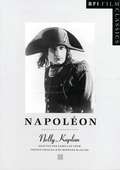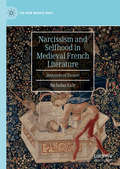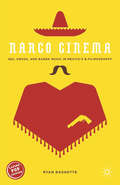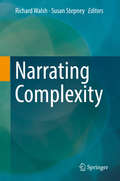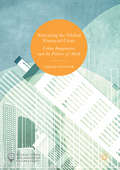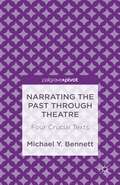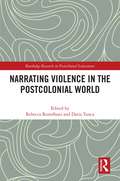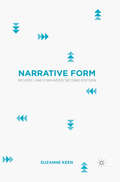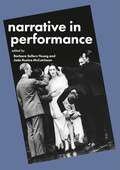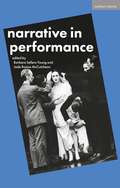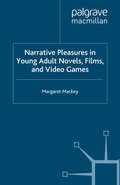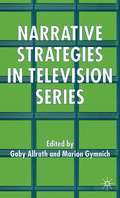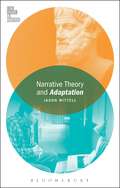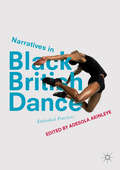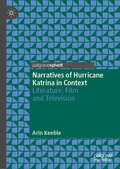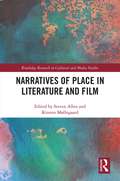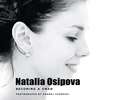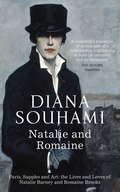- Table View
- List View
Napoleon (BFI Film Classics)
by Nelly KaplanAbel Gance's film, restored through the efforts of Kevin Brownlow, is discussed here by Nelly Kaplan, who was Gance's assistant and then, later, with such productions as 'The Pirate's Fiancee', a film director in her own right. Each volume in the 'BFI Film Classics' series contains a personal commentary on the film, a brief production history and a detailed filmography.
Napoleon (BFI Film Classics)
Abel Gance's film, restored through the efforts of Kevin Brownlow, is discussed here by Nelly Kaplan, who was Gance's assistant and then, later, with such productions as 'The Pirate's Fiancee', a film director in her own right. Each volume in the 'BFI Film Classics' series contains a personal commentary on the film, a brief production history and a detailed filmography.
Narcissism and Selfhood in Medieval French Literature: Wounds of Desire (The New Middle Ages)
by Nicholas EalyThis book offers analyses of texts from medieval France influenced by Ovid’s myth of Narcissus including the Lay of Narcissus, Alain de Lille’s Plaint of Nature, René d’Anjou’s Love-Smitten Heart, Chrétien de Troyes’s Story of the Grail and Guillaume de Machaut’s Fountain of Love. Together, these texts form a corpus exploring human selfhood as wounded and undone by desire. Emerging in the twelfth century in Western Europe, this discourse of the wounded self has survived with ever-increasing importance, informing contemporary methods of theoretical inquiry into mourning, melancholy, trauma and testimony. Taking its cue from the moment Narcissus bruises himself upon learning he cannot receive the love he wants from his reflection, this book argues that the construct of the wounded self emphasizes fantasy over reality, and that only through the world of the imagination—of literature itself—can our narcissistic injuries seemingly be healed and desire fulfilled.
Narco Cinema: Sex, Drugs, and Banda Music in Mexico’s B-Filmography (Latino Pop Culture)
by Ryan RashotteThis book provides the first comprehensive study of narco cinema, a cross-border exploitation cinema that, for over forty years, has been instrumental in shaping narco-culture in Mexico and the US borderlands. Identifying classics in its mammoth catalogue and analyzing select films at length, Rashotte outlines the genre's history and aesthetic criteria. He approaches its history as an alternative to mainstream representation of the drug war and considers how its vernacular aesthetic speaks to the anxieties and desires of Latina/o audiences by celebrating regional cultures while exploring the dynamics of global transition. Despite recent federal prohibitions, narco cinema endures as a popular folk art because it reflects distinctively the experiences of those uprooted by the forces of globalization and critiques those forces in ways mainstream cinema has failed.
Narrating Complexity
by Richard Walsh Susan StepneyThis book stages a dialogue between international researchers from the broad fields of complexity science and narrative studies. It presents an edited collection of chapters on aspects of how narrative theory from the humanities may be exploited to understand, explain, describe, and communicate aspects of complex systems, such as their emergent properties, feedbacks, and downwards causation; and how ideas from complexity science can inform narrative theory, and help explain, understand, and construct new, more complex models of narrative as a cognitive faculty and as a pervasive cultural form in new and old media. The book is suitable for academics, practitioners, and professionals, and postgraduates in complex systems, narrative theory, literary and film studies, new media and game studies, and science communication.
Narrating the Global Financial Crisis: Urban Imaginaries and the Politics of Myth
by Miriam MeissnerThis book analyzes how the Global Financial Crisis is portrayed in contemporary popular culture, using examples from film, literature and photography. In particular, the book explores why particular urban spaces, infrastructures and aesthetics – such as skyline shots in the opening credits of financial crisis films – recur in contemporary crisis narratives. Why are cities and finance connected in the cultural imaginary? Which ideologies do urban crisis imaginaries communicate? How do these imaginaries relate to the notion of crisis? To consider these questions, the book reads crisis narratives through the lens of myth. It combines perspectives from cultural, media and communication studies, anthropology, philosophy, geography and political economy to argue that the concept of myth can offer new and nuanced insights into the structure and politics of popular financial crisis imaginaries. In so doing, the book also asks if, how and under what conditions urban crisis imaginaries open up or foreclose systematic and political understandings of the Global Financial Crisis as a symptom of the broader process of financialization.
Narrating the Global Financial Crisis: Urban Imaginaries and the Politics of Myth (Palgrave Studies in Globalization, Culture and Society)
by Miriam MeissnerThis book analyzes how the Global Financial Crisis is portrayed in contemporary popular culture, using examples from film, literature and photography. In particular, the book explores why particular urban spaces, infrastructures and aesthetics – such as skyline shots in the opening credits of financial crisis films – recur in contemporary crisis narratives. Why are cities and finance connected in the cultural imaginary? Which ideologies do urban crisis imaginaries communicate? How do these imaginaries relate to the notion of crisis? To consider these questions, the book reads crisis narratives through the lens of myth. It combines perspectives from cultural, media and communication studies, anthropology, philosophy, geography and political economy to argue that the concept of myth can offer new and nuanced insights into the structure and politics of popular financial crisis imaginaries. In so doing, the book also asks if, how and under what conditions urban crisis imaginaries open up or foreclose systematic and political understandings of the Global Financial Crisis as a symptom of the broader process of financialization.
Narrating the Past through Theatre: Four Crucial Texts
by M. BennettThis cutting-edge title explores how narrating the past both conflicts and creates an interesting relationship with drama's 'continuing present' that arcs towards an unpredictable future. Theatre both brings the past alive and also fixes it, but through the performance process, allowing the past to be molded for future (not-yet-existent) audiences.
Narrating Violence in the Postcolonial World (Routledge Research in Postcolonial Literatures)
by Rebecca Romdhani Daria TuncaThis book examines representations of violence across the postcolonial world—from the Americas to Australia—in novels, short stories, plays, and films. The chapters move from what appear to be interpersonal instances of violence to communal conflicts such as civil war, showing how these acts of violence are specifically rooted in colonial forms of abuse and oppression but constantly move and morph. Taking its cue from theories in such fields as postcolonial, violence, gender, and trauma studies, the book thus shows that violence is slippery in form, but also fluid in nature, so that one must trace its movement across time and space to understand even a single instance of it. When analysing such forms and trajectories of violence in postcolonial creative writing and films, the contributors critically examine the ethical issues involved in narrating abuse, depicting violated bodies, and presenting romanticized resolutions that may conceal other forms of violence.
Narrating Violence in the Postcolonial World (Routledge Research in Postcolonial Literatures)
by Rebecca Romdhani Daria TuncaThis book examines representations of violence across the postcolonial world—from the Americas to Australia—in novels, short stories, plays, and films. The chapters move from what appear to be interpersonal instances of violence to communal conflicts such as civil war, showing how these acts of violence are specifically rooted in colonial forms of abuse and oppression but constantly move and morph. Taking its cue from theories in such fields as postcolonial, violence, gender, and trauma studies, the book thus shows that violence is slippery in form, but also fluid in nature, so that one must trace its movement across time and space to understand even a single instance of it. When analysing such forms and trajectories of violence in postcolonial creative writing and films, the contributors critically examine the ethical issues involved in narrating abuse, depicting violated bodies, and presenting romanticized resolutions that may conceal other forms of violence.
Narrative Form: Revised and Expanded Second Edition
by Suzanne KeenThis revised and expanded handbook concisely introduces narrative form to advanced students of fiction and creative writing, with refreshed references and new discussions of cognitive approaches to narrative, nonfiction, and narrative emotions.
Narrative in Performance
by Barbara Sellers-Young and Jade Rosina McCutcheonA far-reaching and engaging overview of the role of narrative in dance and theatre performance, bringing together chapters written by an international range of scholars and subsequently creating a critical dialogue for approaching this fundamental topic within performance studies. Drawing on historical and contemporary examples of a variety of different performance genres, the book will provide a method for exploring the context of a particular form or artist and enhance students' ability to critically reflect on performance.
Narrative in Performance
by Barbara Sellers-Young Jade Rosina McCutcheonA far-reaching and engaging overview of the role of narrative in dance and theatre performance, bringing together chapters written by an international range of scholars and subsequently creating a critical dialogue for approaching this fundamental topic within performance studies. Drawing on historical and contemporary examples of a variety of different performance genres, the book will provide a method for exploring the context of a particular form or artist and enhance students’ ability to critically reflect on performance.
Narrative Pleasures in Young Adult Novels, Films and Video Games (Critical Approaches to Children's Literature)
by M. MackeyStories are told today through many formats and young interpreters bring multimedia experience to bear on every narrative format they encounter. In this book, twelve young people read a novel, watch a film and play a video game from beginning to end. Their responses inform a new framework of contemporary themes of narrative comprehension.
Narrative Podcasting in an Age of Obsession
by Neil VermaIt has been a decade since Serial brought the narrative podcast to the center of popular culture. In that time, there has been an enormous boom in the production of podcasts that tell stories, particularly in the fields of true crime, storytelling, history, and narrative fiction. Now that the initial glow around the medium has begun to fade, it is time to reevaluate the medium’s technological, political, economic, and cultural rise, in particular what types of storytelling accompanied that rise. Narrative Podcasting in an Age of Obsession is the first book to look back on this prodigious body of material and attempt to make sense of it from a structural, historical, and analytic point of view. Focusing on more than 350 podcasts and other audio works released between Serial and the COVID pandemic, the book explores why so many of these podcasts seem “obsessed with obsession,” why they focus not only on informing listeners but also dramatizing the labor that goes into it, and why fiction podcasts work so hard to prove they are a brand new form, even as they revive features of radio from decades gone by. This work also examines the industry's reckoning with its own implication in systemic racism, misogyny, and other forms of discrimination. Employing innovative new critical techniques for close listening—including pitch tracking software and spectrograms—Narrative Podcasting in an Age of Obsession makes a major contribution to podcast studies and media studies more broadly.
Narrative Strategies in Television Series
by G. Allrath M. GymnichIn the context of a systematic overview of the possibilities of applying narratological concepts to a study of TV series, ten case studies are explored in depth, demonstrating how series such as 24, Buffy, Twin Peaks, Star Trek, Blackadder, and Sex and the City make use of innovative audiovisual means of storytelling. Transgressing the traditional confines of narrative theory, the chapter authors address the question of how form, content, and function intersect in these series.
Narrative Theory and Adaptation. (Film Theory in Practice)
by Jason MittellNarrative Theory and Adaptation offers a concise introduction to narrative theory in jargon-free language and shows how this theory can be deployed to interpret Spike Jonze's critically acclaimed 2002 film Adaptation. Understanding narrative theory is crucial to make sense of the award-winning film Adaptation. The book explicates, in clear prose for beginners, four key facets important to the narrative theory of film: the distinction between practical vs. critical theory, the role of adaptation, the process of narrative comprehension, and notions of authorship. It then works to unlock Adaptation using these four keys in succession, considering how the film demands a theoretical understanding of the storytelling process. In using this unusual case study of a film, the author makes the case for the importance of narrative theory as a general perspective for filmmakers, critics, and viewers alike.
Narrative Theory and Adaptation. (Film Theory in Practice)
by Jason MittellNarrative Theory and Adaptation offers a concise introduction to narrative theory in jargon-free language and shows how this theory can be deployed to interpret Spike Jonze's critically acclaimed 2002 film Adaptation. Understanding narrative theory is crucial to make sense of the award-winning film Adaptation. The book explicates, in clear prose for beginners, four key facets important to the narrative theory of film: the distinction between practical vs. critical theory, the role of adaptation, the process of narrative comprehension, and notions of authorship. It then works to unlock Adaptation using these four keys in succession, considering how the film demands a theoretical understanding of the storytelling process. In using this unusual case study of a film, the author makes the case for the importance of narrative theory as a general perspective for filmmakers, critics, and viewers alike.
Narratives in Black British Dance: Embodied Practices
by Adesola AkinleyeThis book explores Black British dance from a number of previously-untold perspectives. Bringing together the voices of dance-artists, scholars, teachers and choreographers, it looks at a range of performing arts from dancehall to ballet, providing valuable insights into dance theory, performance, pedagogy, identity and culture. It challenges the presumption that Blackness, Britishness or dance are monolithic entities, instead arguing that all three are living networks created by rich histories, diverse faces and infinite future possibilities. Through a variety of critical and creative essays, this book suggests a widening of our conceptions of what British dance looks like, where it appears, and who is involved in its creation.
Narratives in Black British Dance: Embodied Practices
by Adesola AkinleyeThis book explores Black British dance from a number of previously-untold perspectives. Bringing together the voices of dance-artists, scholars, teachers and choreographers, it looks at a range of performing arts from dancehall to ballet, providing valuable insights into dance theory, performance, pedagogy, identity and culture. It challenges the presumption that Blackness, Britishness or dance are monolithic entities, instead arguing that all three are living networks created by rich histories, diverse faces and infinite future possibilities. Through a variety of critical and creative essays, this book suggests a widening of our conceptions of what British dance looks like, where it appears, and who is involved in its creation.
Narratives of Hurricane Katrina in Context: Literature, Film and Television
by Arin KeebleThis book analyzes six key narratives of Hurricane Katrina across literature, film and television from the literary fiction of Jesmyn Ward to the cinema of Spike Lee. It argues that these texts engage with the human tragedy and political fallout of the Katrina crisis while simultaneously responding to issues that have characterized the wider, George W. Bush era of American history; notably the aftermath of 9/11 and ensuing War on Terror. In doing so it recognizes important challenges to trauma studies as an interpretive framework, opening up a discussion of the overlaps between traumatic rupture and systemic or, “slow violence.”
Narratives of Place in Literature and Film (Routledge Research in Cultural and Media Studies)
by Steven Allen Kirsten MøllegaardNarratives of place link people and geographic location with a cultural imaginary through literature and visual narration. Contemporary literature and film often frame narratives with specific geographic locations, which saturate the narrative with cultural meanings in relation to natural and man-made landscapes. This interdisciplinary collection seeks to interrogate such connections to probe how place is narrativized in literature and film. Utilizing close readings of specific filmic and literary texts, all chapters serve to tease out cultural and historical meanings in respect of human engagement with landscapes. Always mindful of national, cultural and topographical specificity, the book is structured around five core themes: Contested Histories of Place; Environmental Landscapes; Cityscapes; The Social Construction of Place; and Landscapes of Belonging.
Narratives of Place in Literature and Film (Routledge Research in Cultural and Media Studies)
by Steven Allen Kirsten MøllegaardNarratives of place link people and geographic location with a cultural imaginary through literature and visual narration. Contemporary literature and film often frame narratives with specific geographic locations, which saturate the narrative with cultural meanings in relation to natural and man-made landscapes. This interdisciplinary collection seeks to interrogate such connections to probe how place is narrativized in literature and film. Utilizing close readings of specific filmic and literary texts, all chapters serve to tease out cultural and historical meanings in respect of human engagement with landscapes. Always mindful of national, cultural and topographical specificity, the book is structured around five core themes: Contested Histories of Place; Environmental Landscapes; Cityscapes; The Social Construction of Place; and Landscapes of Belonging.
Natalia Osipova: Becoming A Swan
by Andrej UspenskiNatalia Osipova: Becoming a Swan is an intimate portrait of the work of a ballet superstar, and the story told in pictures of how she prepares for the most iconic role in all of ballet. Features over 150 black and white images of Osipova behind the scenes and on stage, including unique glimpses taken from the wings at Covent Garden. Andrej Uspenski has used his exclusive vantage point as a First Artist with The Royal Ballet, to produce a moving photographic tribute to the most exciting prima ballerina in the world today.Foreword by Alexander Agadzhanov, the Royal Ballet's Senior Teacher and Répétiteur
Natalie and Romaine: The Lives and Loves of Natalie Barney and Romaine Brooks
by Diana SouhamiNatalie Barney,'the wild girl of Cincinnati', and Romaine Brooks were both rich, American and grandly lesbian. They met in Paris in 1915 and their tempestuous affair lasted more than fifty years. By the end of their lives together, Natalie and Romaine had entertained, slept with, fallen in love with, tutored or tortured a range of figures including Gertrude Stein, Colette, Edith Sitwell, Gabriele d'Annunzio and the ballerina Ida Rubinstein. But among this tumult there was an enduring and loving relationship that supported a liberating spirit of culture, style and candour. In this vivid double biography, Souhami writes with complexity and skill, drawing the reader into a different world and capturing for ever her subjects' extraordinary lives.
